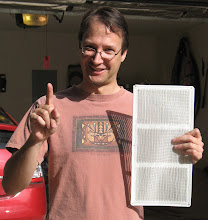What this means for energy efficiency in the summertime in a sunny climate is this: if you're addressing only the hot outside air, which can affect your home only through the mechanisms of convection and conduction, you are acting like the lone cow out in the field standing in the sun on a 100 degree day, while the rest of the herd is standing in the shade: that is, you are ignoring the most important part of keeping cool.
So wouldn't it be great if there were a way to bounce that bombardment of photons right back into the sky where it came from? Wouldn't that significantly reduce the amount of energy being absorbed into a house, reducing the amount of electricity an air conditioner has to expend to remove that energy once it strikes something and becomes heat? Yes, and most definitively, yes! Enter the radiant barrier.
Officially, a radiant barrier is defined as any material that reflects 90% or more of the energy striking it, which implies that it absorbs less than 10%. There are different types of radiant barriers that you can place at various spots between yourself and the sun, including items as simple as lighter colored shingles, with the lighter color reflecting more of the sunlight than darker colors (although these don't tend to reach the 90% standard to be considered true radiant barriers) to silvered roof decking, to reflective paints, to large amounts of industrial-grade foil.



No comments:
Post a Comment